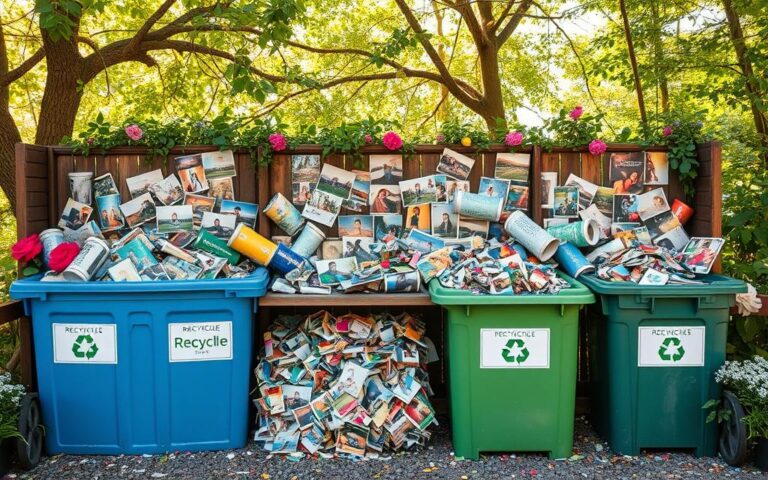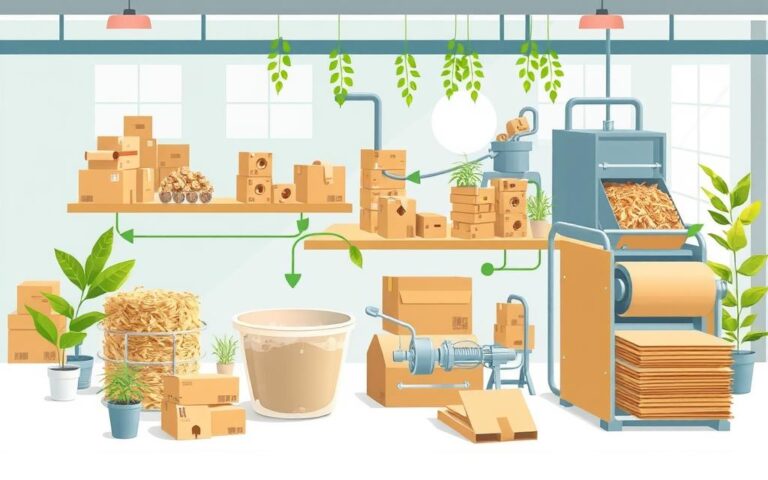How to Recycle Clothes Hangers: Best Practices
Recycling clothes hangers is key to being eco-friendly. Most wardrobes today use plastic hangers. It’s vital to know how to recycle them to cut waste and support sustainable clothes storage. Shockingly, only 9% of all plastic made has been recycled. This fact shows we need better recycling habits urgently.
Many don’t know the difficulties in recycling hangers. Recycling centres often don’t take wire hangers because they jam machines. Wood hangers, treated with varnish, can’t be recycled. Plastic hangers, made of different materials, also pose a challenge. Yet, thrift stores sell plastic hangers, and some places offer few recycling options. Knowing how to recycle properly is therefore very important.
Understanding the Environmental Impact of Clothes Hangers
Clothes hangers have a big environmental impact but people often don’t notice it. Every year, billions of hangers end up in the trash, adding to the planet’s plastic waste issue. Fast fashion worsens the problem, with a huge 10 billion hangers made worldwide annually. Most of these, around 85%, end up in landfills.
The Plastic Problem
Hangers are usually made from a mix of several plastics and metals. This makes it hard to dispose of them properly. Plastic hangers are often made of polystyrene, which carries a recycling symbol but is rarely accepted by recycling facilities. This leads to challenges in recycling.
The problem is big: each plastic hanger creates about 0.16 kilograms of CO2. And with 40 billion used each year, we must think about their full life cycle. It’s important to consider how they are made, used, and thrown away.
Recycling Challenges
Trying to recycle hangers is good, but it’s not easy. Metal hangers, for example, can be tough to recycle because of their shape and the mix of materials they’re made from. This can cause problems at recycling centers, which might not accept them. The dry cleaning industry adds to the problem by using 200 million steel hangers each year that can’t be recycled.
Hangers can take up to 1,000 years to break down, making their environmental impact significant. Fortunately, some companies like Kleiderly are working on solutions. They make hangers from recycled clothing waste, showing that innovative ideas are needed to solve this recycling challenge.
How to Recycle Clothes Hangers
Recycling clothes hangers can be a bit tricky due to varying local recycling rules. It’s key to understand these guidelines before you get rid of your hangers. Many recycling programmes do not accept plastic hangers because of the materials used. Metal hangers often face similar problems. Learning about the available options helps with eco-friendly disposal of these items.
Check Local Recycling Guidelines
Consulting local recycling guidelines is crucial. This will help you know if your hangers can be recycled. This varies across regions. Some facilities won’t take metal hangers because they can mess up sorting equipment. Here are some major points to bear in mind about local recycling:
- Plastic hangers are commonly rejected by recycling centres.
- Metal hangers may be accepted in certain curbside programmes in cities like New York City.
- Wood hangers, due to their treated finish, are generally non-recyclable.
Alternative Recycling Options
If local recycling centres reject your hangers, don’t worry. There are alternative ways to dispose of them responsibly. Here are some eco-friendly disposal ideas:
- You can return plastic hangers to retail stores like Target and Kohl’s; they often have take-back programmes.
- Consider giving metal hangers to dry cleaners. They commonly accept them back for reuse.
- Local thrift shops may be keen to take hanger donations. They need them for displaying their clothing items.
Understanding your local recycling rules and finding alternative recycling options makes disposal more eco-friendly. Every effort helps to lighten the plastic waste load on our environment.
| Type of Hanger | Recyclable? | Notes |
|---|---|---|
| Plastic Hangers | No | Most centres reject these due to material complexity. |
| Metal Hangers | Sometimes | Accepted in some cities; always check local guidelines. |
| Wood Hangers | No | Treated with finishes, making them non-recyclable. |
Creative Ways to Repurpose Old Hangers
Recycling clothes hangers is a challenge, but we can turn to creative solutions. Every year, we produce 8 to 10 billion plastic and wire hangers. It’s crucial to find new uses for them. By focusing on upcycling, we can make old hangers useful and decorative again.
Upcycling Ideas
There are many fun and creative ways to reuse old hangers:
- Wreaths: Use wire hangers to make seasonal wreaths. You can decorate them with ornaments or flowers.
- Storage solutions: Transform your crafting area. Use hangers to organize supplies or turn a wire hanger’s cardboard bottom into a toilet paper holder.
- Book holders: Shape wire hangers into book holders. They help keep your books tidy and within easy reach.
- Sandal hangers: Make unique sandal displays by reshaping wire hangers.
The possibilities for creativity are endless. Children especially find joy in making and seeing their crafts at home. Turning a hanger into a storage space by bending it and adding clips is a simple yet effective idea.
Donating and Selling Hangers
Wooden hangers are welcome at many thrift stores and shelters. However, it’s harder to donate plastic and wire hangers. Despite this, charities such as Goodwill and The Salvation Army still find them useful. These donations support their community work.
Metal hangers are accepted at scrap metal facilities. This makes recycling them a good option. There are many ways to upcycle or donate hangers. This helps keep them out of landfills and gives them a new life.

| Type of Hanger | Upcycling Ideas | Donation Opportunities |
|---|---|---|
| Plastic Hangers | Organise accessories, manage cables, display recipes | Limited; check with local charities |
| Wire Hangers | Sandal holder, wreaths, book holders | Dry cleaners, thrift stores |
| Wooden Hangers | Craft projects, storage solutions | Commonly accepted at thrift stores |
Best Practices for Reducing Hanger Waste
Reducing hanger waste is essential for our planet’s health. Choosing eco-friendly hangers helps lower the environmental harm. Eco-friendly hangers, like Ditto’s which are made from recycled paper, are a great substitute for plastic ones.
Choose Sustainable Alternatives
About 8 billion plastic hangers get thrown away annually. This shocking number shows why we need greener options. Tesco is leading by example with their hanger recycling programs. Recycled and brass hangers are both reliable and nicer-looking alternatives.
Encourage Hanger Reuse
Reusing hangers is a powerful way to cut waste. Dry cleaners and thrift shops often welcome used metal hangers. Letting people know about non-plastic options helps spread green habits. Donation spots like The Stock Exchange accept used hangers, helping everyone contribute.
| Type of Hanger | Recycling Options | Sustainable Alternatives |
|---|---|---|
| Plastic Hangars | Often not recyclable due to mixed materials | Recycled paper fibreboard hangers |
| Wooden Hangers | Varnish makes recycling difficult | Solid brass or rattan hangers |
| Metal Hangers | Can be returned to dry cleaners for reuse | Aluminium or cedar wood hangers |
Choosing sustainable practices can make a big difference in reducing waste. This lifestyle not only helps our planet but also encourages others to act. For tips on recycling hangers, check out this resource.
Conclusion
Recycling clothes hangers is essential for a green future. The use of polystyrene and polypropylene in hangers poses challenges. We must act thoughtfully when recycling and getting rid of them.
To recycle effectively, check local recycling rules and think of creative ways to reuse hangers. Supporting shops that care about the environment is good too. Every little bit helps, like reusing hangers or choosing ones made of bamboo.
Making eco-friendly choices fights the waste problem and leads to a greener tomorrow. Let’s all do our part. By doing so, we’re not just cutting down on waste. We’re also taking care of our planet for future generations.
FAQ
How can I properly recycle plastic hangers?
Recycling plastic hangers can be tricky. They’re made of mixed materials. Always check with your local recycling centre first. If they don’t take them, try returning them to shops like Target or Walmart. These stores sometimes have their recycling programmes.
What should I do with metal hangers?
Metal hangers are tough for many recycling centres to handle. Their shape and metal can break machines. If you can’t recycle them, think about giving them away. Thrift shops or groups in need might want them for reuse.
Are wooden hangers recyclable?
Yes, wooden hangers are easier to recycle than plastic or metal ones. But you should still check with your local facilities. Or, you could give them to charity shops. There, they can be used again to display clothes.
What innovative ways can I upcycle clothes hangers?
Get creative with your old hangers! Turn them into wreaths, use them for organising things, or make art for the garden. These fun projects reduce waste and add a personal flair to your space.
How can I encourage eco-friendly hanger practices among my friends?
Lead by example with your green habits. Suggest to friends that they avoid plastic hangers. Talk about the good of reusing and recycling hangers. Working together makes a big difference in cutting down on hanger waste.
Why is it important to recycle clothes hangers?
It’s key to cut down on plastic waste with recycling hangers. A big chunk of hangers are plastic. Recycling them helps us do more for the environment and leads to a cleaner future.
Where can I donate clothes hangers?
Give them to thrift stores or charity groups that need them for clothing. Also, some shops take back hangers for recycling. It’s worth asking around in your community.
What are some eco-friendly alternatives to traditional hangers?
Seek out hangers made from recycled stuff. Ditto’s eco-friendly hangers are a good pick. They’re made from recycled paper fibreboard. This choice helps reduce plastic use and supports a sustainable way to keep clothes.















